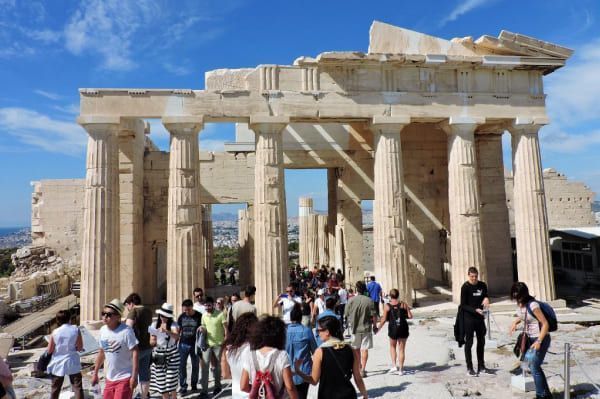
Acropolis Museum Tickets
Entry ticket
Acropolis Museum tickets

General information
- Mobile tickets
- Secure your entry
- Instant confirmation
- Wheelchair accessible
Enjoy the Acropolis Museum
Discover one of the most important archaeological museums in the world with your Acropolis Museum Ticket. Located at the foot of the Acropolis, the museum houses over 4,000 artifacts from the Sacred Rock and its surrounding slopes, showcasing the evolution of Athenian civilization.
Admire masterpieces from ancient Greece, including the Caryatids, the Parthenon Frieze, and the statues of Athena and Poseidon. Explore the glass floors revealing the archaeological excavations beneath the museum, and enjoy panoramic views of the Acropolis from the top-floor Parthenon Gallery.
This ticket grants you direct access to all permanent and temporary exhibitions — an essential experience for anyone visiting Athens.
What is included in the Acropolis Museum ticket?
- Entry to the Acropolis Museum
- Access to permanent and temporary exhibitions
- Access to the Parthenon Gallery and archaeological excavation site beneath the museum
- Booking fees and taxes
- Guided tour
- Cancellation option
Enhance your experience with the Combo Ticket

Acropolis Combined Ticket
- Access to the Acropolis, Parthenon and other iconic buildings
- Access to the North and South slopes of the Acropolis
- Access to Ancient Agora, Hadrian's Library, Kerameikos, Aristotle's School, Olympieion and Roman Agora
Additional information
The Acropolis Museum is one of the most significant archaeological museums in the world, dedicated to preserving and presenting the treasures of the Athenian Acropolis. Opened in 2009, it was designed by architect Bernard Tschumi in collaboration with Michael Photiadis, and is located just 300 meters from the Parthenon.
Built on top of an ancient Athenian neighborhood visible through its glass floors, the museum houses over 4,000 artifacts discovered on the Acropolis and its slopes. Its light-filled galleries trace the evolution of Athenian art and culture from the Mycenaean period to the 5th century BC.
Among its highlights are the Caryatids of the Erechtheion, the original Parthenon Frieze, and the statues of the Archaic Gallery, all displayed with state-of-the-art lighting and panoramic views of the Acropolis hill. The top-floor Parthenon Gallery aligns perfectly with the temple itself, offering visitors a unique visual connection between the artworks and their original location.
The museum also includes a café-restaurant with Acropolis views, two shops, and an archaeological excavation site open to the public beneath the building. It’s an essential cultural experience for anyone visiting Athens — a bridge between ancient history and modern architecture.
Winter season (November 1 – March 31)
- Monday to Thursday: 09:00 – 17:00
- Friday: 09:00 – 22:00
- Saturday & Sunday: 09:00 – 20:00
Summer season (April 1 – October 31)
- Monday: 09:00 – 17:00
- Tuesday to Sunday: 09:00 – 20:00
- Friday: 09:00 – 22:00
Before your visit
To help preserve the museum’s unique collection and ensure an enjoyable visit for everyone, please keep in mind a few simple guidelines:
Large bags and backpacks must be left at the cloakroom upon entry.
For conservation reasons, please do not touch the exhibits.
Food and drinks are not permitted inside the galleries.
Photography and video are allowed in most areas, except inside the Archaic Gallery, where delicate sculptures still show traces of ancient color.
We recommend setting your mobile phone to silent and avoiding its use while visiting the exhibition areas.
Accessibility
- The Acropolis Museum is designed to be fully accessible for all visitors:
Entrances are equipped with ramps for wheelchairs and strollers.
Elevators and accessible restrooms are available on every floor.
Wheelchairs can be borrowed free of charge from the Visitor Services Desk.
Braille guides (in Greek and English) are available at the Information Desk.
Guide dogs are welcome throughout the museum.
Museum maps can also be obtained at the Information Desk.
Visiting with children
Families are especially welcome at the Acropolis Museum, with several services and activities designed for younger visitors:
Baby strollers are available to borrow at the ground-floor cloakroom.
A parent room for baby care is located on the first floor.
Family activity backpacks and family trails can be borrowed free of charge from the Visitor Services Desk.
A free family audio guide is available to make the visit more engaging for kids.
Children can also enjoy the Kids Corner, located on the second floor next to the restaurant, where they can explore ancient Greece through digital games.
If you have any questions or need help to book your tickets, please do not hesitate to contact us at support@acropolis.athenstickets.org
It is currently not possible to make any cancellations or ticket changes. For further information and assistance please contact support@acropolis.athenstickets.org
FAQs about Acropolis Museum Entry Ticket
Admission to all museum galleries and temporary exhibitions.
Yes, digital tickets are accepted at the entrance.
Yes, the Acropolis Museum is fully accessible.
Yes, the museum restaurant and café offer light meals, coffee, and desserts.
Yes, access is included with your general admission ticket.
Check tickets availability
Free admission tickets are only available at the Museum's Ticket Desk
Location
Address: 15 Dionysiou Areopagitou Street, Athens 11742, Greece.
The Acropolis Museum is located in the heart of Athens, just a few steps from the Acropolis Metro Station and near major landmarks such as the Parthenon and the Theatre of Dionysus.
How to get to the Acropolis Museum
The easiest way to reach the museum is by Metro, stopping at Acropolis Station (Line 2) — only a short walk from the entrance.
You can also take public buses 24, 40, and 230, or a taxi from anywhere in central Athens. If arriving by car, note that parking spaces are limited in the area; public transportation is highly recommended.
Other tickets that may interest you

- Access to the Acropolis, Parthenon and other iconic buildings
- Access to the North and South slopes of the Acropolis
- Booking fees and taxes
- Includes Skip the Line admission

(6k)
Acropolis & Parthenon Ticket
- Access to the Acropolis, Parthenon and other iconic buildings
- Access to the North and South slopes of the Acropolis
- Booking fees and taxes
Payment methods accepted
